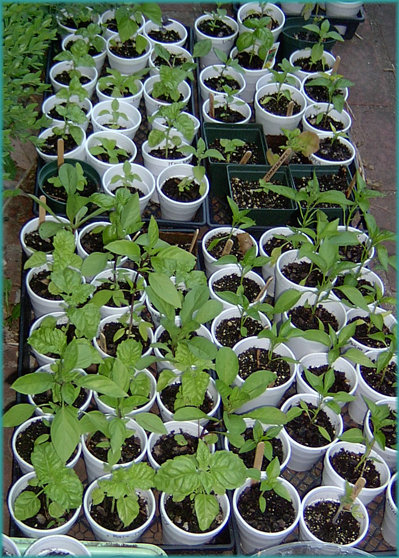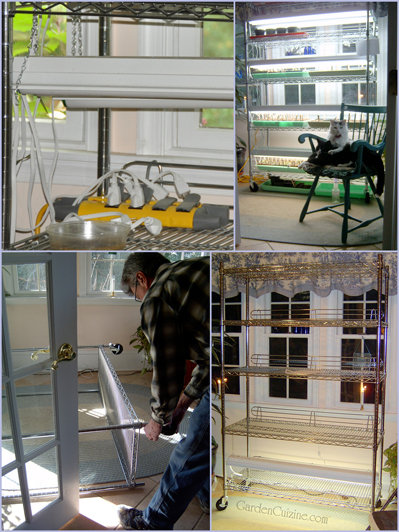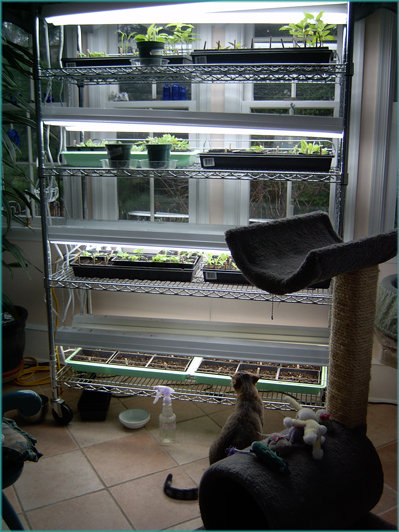





Jump-start your Garden
In my family all our garden plants, with the exception of a few spontaneous purchases, are annually grown from seeds. Now is the time to decide which vegetables, flowers and herbs will benefit from being started in a heated greenhouse or inside your home. Seeding plants indoors is easy, economical, and offers great personal satisfaction.
To begin Growing Indoor Seedlings you will need:
• seeds Some gardeners also like to use timers for their lights and may use a fan to aerate the room. And, if you plan on making your own seedling light cart, you will need a multiple outlet power strip. What about Heat Mats? Seeds in trays warmed atop heat mats germinate faster and are recommended by many gardeners. You can find more information or ask questions in Dave's Garden Seed Germination Discussion Forum.To me; heating mats are a luxury; frankly, we've never used them and our seeds always germinate fine, growing into strong healthy plants. How-to-Make your own Seedling Light Shelves For starting a few vegetables or herbs, you can simply use pots, egg cartons or Styrofoam cups with holes poked in the bottoms and placed in a saucer on a sunny windowsill. If you are an avid or inspired gardener, you will probably benefit from a plant rack and light set up. Have you seen their cost in garden catalogs? Some seedling light carts can be over eight hundred dollars! We put together our own seedling light cart for a fraction of the cost, using a chrome covered steel rack purchased from Costco (under $100) with eight, 4-foot, 2-light, T-8 fluorescent shop light fixtures from Home Depot (about $15.00 ea). When to Start Planting Seeds Indoors The time to start your seedlings will vary depending on your USDA plant hardiness zone and the suggestions on your seed packet label for each specific plant. Seed suppliers generally state sowing recommendations on the package labels. Some seeds need a period of cold stratification and are best winter sown in containers left out during the cold months. Other seeds, including chard, peas, arugula, radish, and lettuce can be directly sown in the soil in early spring, when the weather is still cool. Seeds generally recommended to get started indoors include: tomatoes, tomatillos, basil, parsley and flowers. The flowers we start from seed usually include salvias, nicotiana, and an array from Dave's Garden seed swapping! The seed sowing times vary from a week or two before the last frost date, to 4-8 weeks before the last frost date, depending on the plant. We reside in USDA zone 6b and find a good time to plant most of our vegetable and herb seeds is on or near St. Patrick's Day in March. Pepper plants take longer to grow than tomato plants and can be started a week or two earlier. Certain flower seeds can be started much sooner too, such as Lisianthus, which can be started mid January. Keep a Garden Journal You may find it helpful to keep a gardening journal of your efforts. Notations on the type of seed sown, date planted, date sprouted, date transplanted, photos and harvest dates may be helpful in your efforts the following season. You may also note which plants are heirlooms. Heirloom seeds can be collected, saving you the cost of buying more. Teach Children Have fun planning your garden and don't forget: if you have children, try to get them involved. Studies have shown that children who plan, plant and garden eat more fruits and vegetables. Photographs: Copyright ©2011 D.Wind. All rights reserved. Related DG Article: Seed Starting 101: Setting up Light Shelves for Starting Plants from Seed Indoors, Without a Greenhouse By Jill M. Nicolaus Related Links: Starting Vegetable Seeds Indoors Rutgers NJ Agricultural Experiment Station (NJAES) Fruits and Veggies More Matters Starting Seeds Indoors University of Minnesota Extension
• sterile commercial potting mix
• pots, cups or seed starting flats and inserts
• a watering can
• Popsicle sticks (or plant tags)
• a permanent, water-resistant marker or something to write the names and dates to identify your seedlings and note when they were planted
• and a source of light, which can be a sunny windowsill or fluorescent lights in a warm location
 The lights were hung from lightweight chains and S-hooks, so they could be periodically adjusted to a few inches above the height of the growing seedlings. Our light bulbs were Lumichrome® full spectrum fluorescent - advertised for people, pets and plants. Full spectrum lighting is as close as you can get to natural daylight, and plants seem to love it; however, many gardeners have successfully grown seedlings under standard florescent bulbs.
The lights were hung from lightweight chains and S-hooks, so they could be periodically adjusted to a few inches above the height of the growing seedlings. Our light bulbs were Lumichrome® full spectrum fluorescent - advertised for people, pets and plants. Full spectrum lighting is as close as you can get to natural daylight, and plants seem to love it; however, many gardeners have successfully grown seedlings under standard florescent bulbs. 
Copyright © www.100flowers.win Botanic Garden All Rights Reserved